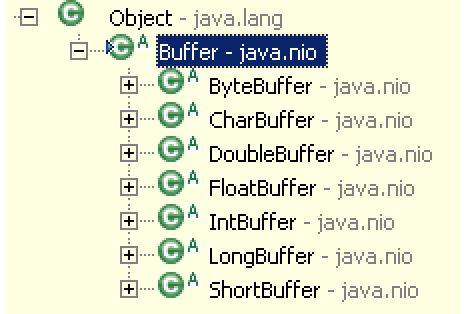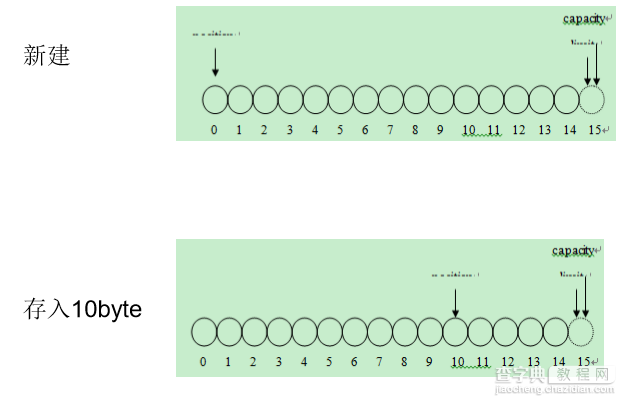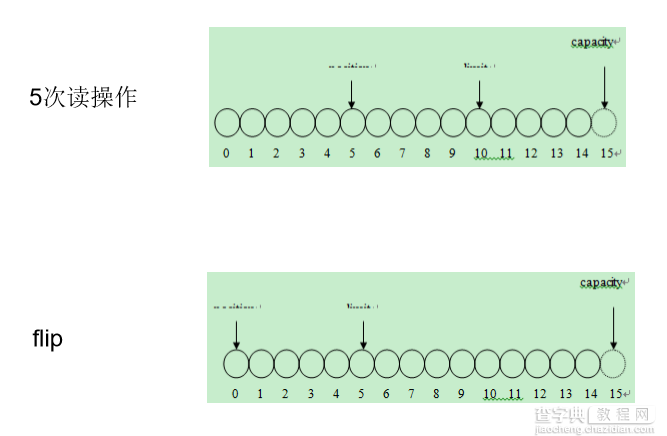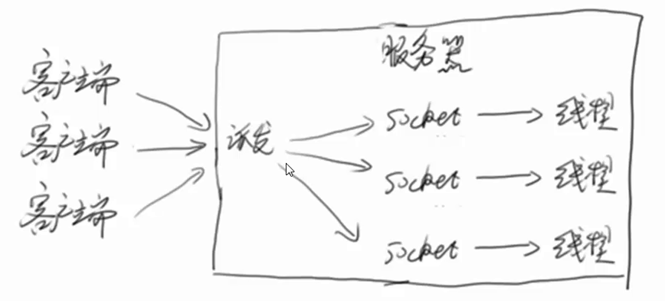IO感觉上和多线程并没有多大关系,但是NIO改变了线程在应用层面使用的方式,也解决了一些实际的困难。而AIO是异步IO和前面的系列也有点关系。在此,为了学习和记录,也写一篇文章来介绍NIO和AIO。
1. 什么是NIO
NIO是New I/O的简称,与旧式的基于流的I/O方法相对,从名字看,它表示新的一套Java I/O标 准。它是在Java 1.4中被纳入到JDK中的,并具有以下特性:
NIO是基于块(Block)的,它以块为基本单位处理数据 (硬盘上存储的单位也是按Block来存储,这样性能上比基于流的方式要好一些) 为所有的原始类型提供(Buffer)缓存支持 增加通道(Channel)对象,作为新的原始 I/O 抽象 支持锁(我们在平时使用时经常能看到会出现一些.lock的文件,这说明有线程正在使用这把锁,当线程释放锁时,会把这个文件删除掉,这样其他线程才能继续拿到这把锁)和内存映射文件的文件访问接口 提供了基于Selector的异步网络I/O

所有的从通道中的读写操作,都要经过Buffer,而通道就是io的抽象,通道的另一端就是操纵的文件。
2. Buffer

Java中Buffer的实现。基本的数据类型都有它对应的Buffer
Buffer的简单使用例子:
package test; import java.io.File; import java.io.FileInputStream; import java.nio.ByteBuffer; import java.nio.channels.FileChannel; public class Test { public static void main(String[] args) throws Exception { FileInputStream fin = new FileInputStream(new File( "d:temp_buffer.tmp")); FileChannel fc = fin.getChannel(); ByteBuffer byteBuffer = ByteBuffer.allocate(1024); fc.read(byteBuffer); fc.close(); byteBuffer.flip();//读写转换 } }
总结下使用的步骤是:
1. 得到Channel
2. 申请Buffer
3. 建立Channel和Buffer的读/写关系
4. 关闭
下面的例子是使用NIO来复制文件:
public static void nioCopyFile(String resource, String destination) throws IOException { FileInputStream fis = new FileInputStream(resource); FileOutputStream fos = new FileOutputStream(destination); FileChannel readChannel = fis.getChannel(); // 读文件通道 FileChannel writeChannel = fos.getChannel(); // 写文件通道 ByteBuffer buffer = ByteBuffer.allocate(1024); // 读入数据缓存 while (true) { buffer.clear(); int len = readChannel.read(buffer); // 读入数据 if (len == -1) { break; // 读取完毕 } buffer.flip(); writeChannel.write(buffer); // 写入文件 } readChannel.close(); writeChannel.close(); }
Buffer中有3个重要的参数:位置(position)、容量(capactiy)和上限(limit)
这里要区别下容量和上限,比如一个Buffer有10KB,那么10KB就是容量,我将5KB的文件读到Buffer中,那么上限就是5KB。
下面举个例子来理解下这3个重要的参数:
public static void main(String[] args) throws Exception { ByteBuffer b = ByteBuffer.allocate(15); // 15个字节大小的缓冲区 System.out.println("limit=" + b.limit() + " capacity=" + b.capacity() + " position=" + b.position()); for (int i = 0; i < 10; i++) { // 存入10个字节数据 b.put((byte) i); } System.out.println("limit=" + b.limit() + " capacity=" + b.capacity() + " position=" + b.position()); b.flip(); // 重置position System.out.println("limit=" + b.limit() + " capacity=" + b.capacity() + " position=" + b.position()); for (int i = 0; i < 5; i++) { System.out.print(b.get()); } System.out.println(); System.out.println("limit=" + b.limit() + " capacity=" + b.capacity() + " position=" + b.position()); b.flip(); System.out.println("limit=" + b.limit() + " capacity=" + b.capacity() + " position=" + b.position()); }
整个过程如图:

此时position从0到10,capactiy和limit不变。

该操作会重置position,通常,将buffer从写模式转换为读 模式时需要执行此方法 flip()操作不仅重置了当前的position为0,还将limit设置到当前position的位置 。
limit的意义在于,来确定哪些数据是有意义的,换句话说,从position到limit之间的数据才是有意义的数据,因为是上次操作的数据。所以flip操作往往是读写转换的意思。

意义同上。
而Buffer中大多数的方法都是去改变这3个参数来达到某些功能的:
public final Buffer rewind()
将position置零,并清除标志位(mark)
public final Buffer clear()
将position置零,同时将limit设置为capacity的大小,并清除了标志mark
public final Buffer flip()
先将limit设置到position所在位置,然后将position置零,并清除标志位mark,通常在读写转换时使用
文件映射到内存
public static void main(String[] args) throws Exception { RandomAccessFile raf = new RandomAccessFile("C:mapfile.txt", "rw"); FileChannel fc = raf.getChannel(); // 将文件映射到内存中 MappedByteBuffer mbb = fc.map(FileChannel.MapMode.READ_WRITE, 0, raf.length()); while (mbb.hasRemaining()) { System.out.print((char) mbb.get()); } mbb.put(0, (byte) 98); // 修改文件 raf.close(); }
对MappedByteBuffer的修改就相当于修改文件本身,这样操作的速度是很快的。
3. Channel
多线程网络服务器的一般结构:

简单的多线程服务器:
public static void main(String[] args) throws Exception { ServerSocket echoServer = null; Socket clientSocket = null; try { echoServer = new ServerSocket(8000); } catch (IOException e) { System.out.println(e); } while (true) { try { clientSocket = echoServer.accept(); System.out.println(clientSocket.getRemoteSocketAddress() + " connect!"); tp.execute(new HandleMsg(clientSocket)); } catch (IOException e) { System.out.println(e); } } }
功能就是服务器端读到什么数据,就向客户端回写什么数据。
这里的tp是一个线程池,HandleMsg是处理消息的类。
static class HandleMsg implements Runnable{ 省略部分信息 public void run(){ try { is = new BufferedReader(new InputStreamReader(clientSocket.getInputStream())); os = new PrintWriter(clientSocket.getOutputStream(), true); // 从InputStream当中读取客户端所发送的数据 String inputLine = null; long b=System. currentTimeMillis (); while ((inputLine = is.readLine()) != null) { os.println(inputLine); } long e=System. currentTimeMillis (); System. out.println ("spend:"+(e - b)+" ms "); } catch (IOException e) { e.printStackTrace(); }finally { 关闭资源 } } }
客户端:
public static void main(String[] args) throws Exception { Socket client = null; PrintWriter writer = null; BufferedReader reader = null; try { client = new Socket(); client.connect(new InetSocketAddress("localhost", 8000)); writer = new PrintWriter(client.getOutputStream(), true); writer.println("Hello!"); writer.flush(); reader = new BufferedReader(new InputStreamReader( client.getInputStream())); System.out.println("from server: " + reader.readLine()); } catch (Exception e) { } finally { // 省略资源关闭 } }
以上的网络编程是很基本的,使用这种方式,会有一些问题:
为每一个客户端使用一个线程,如果客户端出现延时等异常,线程可能会被占用很长时间。因为数据的准备和读取都在这个线程中。此时,如果客户端数量众多,可能会消耗大量的系统资源。
解决方案:
使用非阻塞的NIO (读取数据不等待,数据准备好了再工作)
为了体现NIO使用的高效。
这里先模拟一个低效的客户端来模拟因网络而延时的情况:
private static ExecutorService tp= Executors.newCachedThreadPool(); private static final int sleep_time=1000*1000*1000; public static class EchoClient implements Runnable{ public void run(){ try { client = new Socket(); client.connect(new InetSocketAddress("localhost", 8000)); writer = new PrintWriter(client.getOutputStream(), true); writer.print("H"); LockSupport.parkNanos(sleep_time); writer.print("e"); LockSupport.parkNanos(sleep_time); writer.print("l"); LockSupport.parkNanos(sleep_time); writer.print("l"); LockSupport.parkNanos(sleep_time); writer.print("o"); LockSupport.parkNanos(sleep_time); writer.print("!"); LockSupport.parkNanos(sleep_time); writer.println(); writer.flush(); }catch(Exception e) { } } }
服务器端输出:
spend:6000ms
spend:6000ms
spend:6000ms
spend:6001ms
spend:6002ms
spend:6002ms
spend:6002ms
spend:6002ms
spend:6003ms
spend:6003ms
因为
while ((inputLine = is.readLine()) != null)
是阻塞的,所以时间都花在等待中。
如果用NIO来处理这个问题会怎么做呢?
NIO有一个很大的特点就是:把数据准备好了再通知我
而Channel有点类似于流,一个Channel可以和文件或者网络Socket对应 。

selector是一个选择器,它可以选择某一个Channel,然后做些事情。
一个线程可以对应一个selector,而一个selector可以轮询多个Channel,而每个Channel对应了一个Socket。
与上面一个线程对应一个Socket相比,使用NIO后,一个线程可以轮询多个Socket。
当selector调用select()时,会查看是否有客户端准备好了数据。当没有数据被准备好时,select()会阻塞。平时都说NIO是非阻塞的,但是如果没有数据被准备好还是会有阻塞现象。
当有数据被准备好时,调用完select()后,会返回一个SelectionKey,SelectionKey表示在某个selector上的某个Channel的数据已经被准备好了。
只有在数据准备好时,这个Channel才会被选择。
这样NIO实现了一个线程来监控多个客户端。
而刚刚模拟的网络延迟的客户端将不会影响NIO下的线程,因为某个Socket网络延迟时,数据还未被准备好,selector是不会选择它的,而会选择其他准备好的客户端。
selectNow()与select()的区别在于,selectNow()是不阻塞的,当没有客户端准备好数据时,selectNow()不会阻塞,将返回0,有客户端准备好数据时,selectNow()返回准备好的客户端的个数。
主要代码:
package test; import java.net.InetAddress; import java.net.InetSocketAddress; import java.net.Socket; import java.nio.ByteBuffer; import java.nio.channels.SelectionKey; import java.nio.channels.Selector; import java.nio.channels.ServerSocketChannel; import java.nio.channels.SocketChannel; import java.nio.channels.spi.AbstractSelector; import java.nio.channels.spi.SelectorProvider; import java.util.HashMap; import java.util.Iterator; import java.util.LinkedList; import java.util.Map; import java.util.Set; import java.util.concurrent.ExecutorService; import java.util.concurrent.Executors; public class MultiThreadNIOEchoServer { public static Map<Socket, Long> geym_time_stat = new HashMap<Socket, Long>(); class EchoClient { private LinkedList<ByteBuffer> outq; EchoClient() { outq = new LinkedList<ByteBuffer>(); } public LinkedList<ByteBuffer> getOutputQueue() { return outq; } public void enqueue(ByteBuffer bb) { outq.addFirst(bb); } } class HandleMsg implements Runnable { SelectionKey sk; ByteBuffer bb; public HandleMsg(SelectionKey sk, ByteBuffer bb) { super(); this.sk = sk; this.bb = bb; } @Override public void run() { // TODO Auto-generated method stub EchoClient echoClient = (EchoClient) sk.attachment(); echoClient.enqueue(bb); sk.interestOps(SelectionKey.OP_READ | SelectionKey.OP_WRITE); selector.wakeup(); } } private Selector selector; private ExecutorService tp = Executors.newCachedThreadPool(); private void startServer() throws Exception { selector = SelectorProvider.provider().openSelector(); ServerSocketChannel ssc = ServerSocketChannel.open(); ssc.configureBlocking(false); InetSocketAddress isa = new InetSocketAddress(8000); ssc.socket().bind(isa); // 注册感兴趣的事件,此处对accpet事件感兴趣 SelectionKey acceptKey = ssc.register(selector, SelectionKey.OP_ACCEPT); for (;;) { selector.select(); Set readyKeys = selector.selectedKeys(); Iterator i = readyKeys.iterator(); long e = 0; while (i.hasNext()) { SelectionKey sk = (SelectionKey) i.next(); i.remove(); if (sk.isAcceptable()) { doAccept(sk); } else if (sk.isValid() && sk.isReadable()) { if (!geym_time_stat.containsKey(((SocketChannel) sk .channel()).socket())) { geym_time_stat.put( ((SocketChannel) sk.channel()).socket(), System.currentTimeMillis()); } doRead(sk); } else if (sk.isValid() && sk.isWritable()) { doWrite(sk); e = System.currentTimeMillis(); long b = geym_time_stat.remove(((SocketChannel) sk .channel()).socket()); System.out.println("spend:" + (e - b) + "ms"); } } } } private void doWrite(SelectionKey sk) { // TODO Auto-generated method stub SocketChannel channel = (SocketChannel) sk.channel(); EchoClient echoClient = (EchoClient) sk.attachment(); LinkedList<ByteBuffer> outq = echoClient.getOutputQueue(); ByteBuffer bb = outq.getLast(); try { int len = channel.write(bb); if (len == -1) { disconnect(sk); return; } if (bb.remaining() == 0) { outq.removeLast(); } } catch (Exception e) { // TODO: handle exception disconnect(sk); } if (outq.size() == 0) { sk.interestOps(SelectionKey.OP_READ); } } private void doRead(SelectionKey sk) { // TODO Auto-generated method stub SocketChannel channel = (SocketChannel) sk.channel(); ByteBuffer bb = ByteBuffer.allocate(8192); int len; try { len = channel.read(bb); if (len < 0) { disconnect(sk); return; } } catch (Exception e) { // TODO: handle exception disconnect(sk); return; } bb.flip(); tp.execute(new HandleMsg(sk, bb)); } private void disconnect(SelectionKey sk) { // TODO Auto-generated method stub //省略略干关闭操作 } private void doAccept(SelectionKey sk) { // TODO Auto-generated method stub ServerSocketChannel server = (ServerSocketChannel) sk.channel(); SocketChannel clientChannel; try { clientChannel = server.accept(); clientChannel.configureBlocking(false); SelectionKey clientKey = clientChannel.register(selector, SelectionKey.OP_READ); EchoClient echoClinet = new EchoClient(); clientKey.attach(echoClinet); InetAddress clientAddress = clientChannel.socket().getInetAddress(); System.out.println("Accepted connection from " + clientAddress.getHostAddress()); } catch (Exception e) { // TODO: handle exception } } public static void main(String[] args) { // TODO Auto-generated method stub MultiThreadNIOEchoServer echoServer = new MultiThreadNIOEchoServer(); try { echoServer.startServer(); } catch (Exception e) { // TODO: handle exception } } }
代码仅作参考,主要的特点是,对不同事件的感兴趣来做不同的事。
当用之前模拟的那个延迟的客户端时,这次的时间消耗就在2ms到11ms之间了。性能提升是很明显的。
总结:
1. NIO会将数据准备好后,再交由应用进行处理,数据的读取/写入过程依然在应用线程中完成,只是将等待的时间剥离到单独的线程中去。
2. 节省数据准备时间(因为Selector可以复用)
5. AIO
AIO的特点:
1. 读完了再通知我
2. 不会加快IO,只是在读完后进行通知
3. 使用回调函数,进行业务处理
AIO的相关代码:
AsynchronousServerSocketChannel
server = AsynchronousServerSocketChannel.open().bind( new InetSocketAddress (PORT));
使用server上的accept方法
public abstract <A> void accept(A attachment,CompletionHandler<AsynchronousSocketChannel,? super A> handler);
CompletionHandler为回调接口,当有客户端accept之后,就做handler中的事情。
示例代码:
server.accept(null, new CompletionHandler<AsynchronousSocketChannel, Object>() { final ByteBuffer buffer = ByteBuffer.allocate(1024); public void completed(AsynchronousSocketChannel result, Object attachment) { System.out.println(Thread.currentThread().getName()); Future<Integer> writeResult = null; try { buffer.clear(); result.read(buffer).get(100, TimeUnit.SECONDS); buffer.flip(); writeResult = result.write(buffer); } catch (InterruptedException | ExecutionException e) { e.printStackTrace(); } catch (TimeoutException e) { e.printStackTrace(); } finally { try { server.accept(null, this); writeResult.get(); result.close(); } catch (Exception e) { System.out.println(e.toString()); } } } @Override public void failed(Throwable exc, Object attachment) { System.out.println("failed: " + exc); } });
这里使用了Future来实现即时返回,关于Future请参考上一篇
在理解了NIO的基础上,看AIO,区别在于AIO是等读写过程完成后再去调用回调函数。
NIO是同步非阻塞的
AIO是异步非阻塞的
由于NIO的读写过程依然在应用线程里完成,所以对于那些读写过程时间长的,NIO就不太适合。
而AIO的读写过程完成后才被通知,所以AIO能够胜任那些重量级,读写过程长的任务。
【Java 高并发八:NIO和AIO详解】相关文章:
